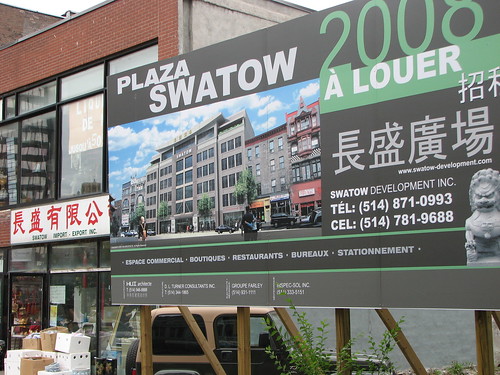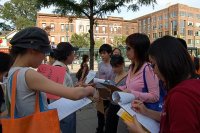Pâtisserie La Légende 麗晶餅屋 undergoing renovations Pâtisserie-restaurant Callia (嘉莉/麵包茶餐聽) Side of Pâtisserie Harmonie 麵包蜜語 Whereas the Chinese “food scene” (you can hardly call it a food scene when a city lacks quality Beijing and Shanghai cuisine) in 2009 has been dominated with the arrival of numerous restaurants and eateries opened by Mainland Chinese immigrants in … Continue reading “Bakery renewal or when urban renovation goes through the stomach”

Pâtisserie La Légende 麗晶餅屋 undergoing renovations

Pâtisserie-restaurant Callia (嘉莉/麵包茶餐聽)

Side of Pâtisserie Harmonie 麵包蜜語
Whereas the Chinese “food scene” (you can hardly call it a food scene when a city lacks quality Beijing and Shanghai cuisine) in 2009 has been dominated with the arrival of numerous restaurants and eateries opened by Mainland Chinese immigrants in Montreal’s new Chinatown, that of the traditional Chinatown on De la Gauchetière (between St-Urbain and Clark) was mostly revamped in the past two years with new Cantonese-owned shops, three of which happen to be bakeries.
Already in the winter of 2008, Harmonie (麵包蜜語) shook Montreal’s Chinese bakery standards by opening at the corner of St-Urbain and De la Gauchetière. Buns left to die on a colourless counter were a thing of the past. Now, Chinese pastries and other bite-size delicacies or cakes would be served in a decor on par with at least what you would see in Hong Kong or other larger Chinatowns of North America: lit-up counters, uniformed staff, floral decorations.
A year later in April 2009, a first competitor Restaurant Callia (嘉莉) was opened (by the family owning Chinese restaurant Keung Kee) across the street. It added the dining space and kitchen that Harmonie did not have, serving Hong Kong’s famed Cha chaan teng-style food of milk tea, beef brisket noodles and Italian noodles in Cantonese sauce, under big TV screens spouting soaps from TVB.
Now on my last visit of Chinatown during the Holidays, I noticed that my grandparents’ favourite (and personal longtime favourite, for lack of anything else) M.M. Légende took over the trendy “Asian-style” clothing store next door and hid behind wooden planks as it is undergoing renovations. For the past two years, I believe that it was to become the first casualty of the Callia/Harmonie combination. So instead, it renamed itself as Pâtisserie La Légende (麗晶餅屋) and decided to expand. Follow-ups would be greatly appreciated!
Maybe now this first casualty would be Dobe & Andy (right under of Kam Fung) if they don’t change. I’m now curious to see what is going to happen with this new huge space for a cha chaan teng, in spite of more restaurant space made available with the imminent inauguration of Plaza Swatow (長盛廣場).
Saturation, or serious signs of Chinese Montrealers moving back to Chinatown? My opinion is that this will largely depend on affordable parking space made available in the area from the Swatow building. Right now, paid parking is prohibitively expensive (no incentive as in downtown Montreal) and free spots can only be found four or five blocks away. A pleasure for nearby residents and public transit users, but a chore for a certain class of car-going suburbanites that I grew up with…































